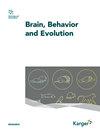褪黑激素在温度诱导的Garter蛇神经内分泌生殖轴激活中的作用
IF 1.8
4区 心理学
Q3 BEHAVIORAL SCIENCES
引用次数: 1
摘要
动物对不断变化的环境条件做出最佳反应的能力对于成功繁殖和最大限度地提高适应性至关重要。对光周期诱导的神经甲状腺激素代谢变化的研究最终将环境线索与鸟类和哺乳动物的神经内分泌生殖轴联系起来。然而,这种保守的机制是否也能传导环境温度的变化还没有完全解决。我们研究了褪黑激素是否介导低温休眠对红边吊带蛇下丘脑甲状腺激素代谢的影响。为了解决这个问题,我们使用免疫组织化学方法来评估垂体底泡中促甲状腺激素(TSH)和下丘脑中去碘酶3 (Dio3)和促性腺激素释放激素(GnRH)的变化。我们还询问了TSH、Dio3和/或GnRH免疫反应性的变化是否与雄性求偶行为的变化有关。与我们的预测相反,在4°C下休眠6周显著减少了漏斗中tsh标记细胞的数量。观察到的TSH下降可能与从高温耐火中释放蛇有关,但这种想法需要进一步验证。在4°C的休眠状态下,用褪黑素前体5-羟色氨酸处理蛇,既逆转了温度引起的TSH免疫反应性变化,又破坏了雄性求偶行为的时间模式。这些结果表明,漏斗内的TSH细胞既受温度调节,又对褪黑激素的变化敏感。正如预测的那样,雄蛇在12°C的高温下冬眠6周,并且用交通工具处理后,TSH-, Dio3-或gnrh免疫反应细胞数量没有变化。用褪黑激素受体拮抗剂luzindole治疗蛇不足以挽救12°C休眠对TSH免疫反应性或求爱行为的影响。然而,经luzindole处理的蛇显示GnRH免疫反应细胞数量显著增加,表明褪黑激素对吊带蛇的GnRH有抑制作用。总之,我们的研究结果为温度对生殖生理和行为的调节机制提供了重要的见解。本文章由计算机程序翻译,如有差异,请以英文原文为准。
Role of Melatonin in Temperature-Induced Activation of the Neuroendocrine Reproductive Axis in Garter Snakes
An animal’s ability to respond optimally to changing environmental conditions is paramount to successfully reproducing and thus maximizing fitness. Studies on photoperiod-induced changes in neural thyroid hormone metabolism have conclusively linked environmental cues to the neuroendocrine reproductive axis of birds and mammals. Whether this conserved mechanism also transduces changes in environmental temperature, however, has not been fully addressed. We investigated whether the hormone melatonin mediates the effects of low-temperature dormancy on thyroid hormone metabolism within the hypothalamus of red-sided garter snakes (Thamnophis sirtalis parietalis). To address this question, we used immunohistochemistry to assess changes in thyroid-stimulating hormone (TSH) in the infundibulum of the pituitary and deiodinase 3 (Dio3) and gonadotropin-releasing hormone (GnRH) in the hypothalamus. We also asked if changes in TSH, Dio3, and/or GnRH immunoreactivity are associated with changes in male courtship behavior. In contrast to our predictions, 6 weeks of dormancy at 4°C significantly decreased the number of TSH-labeled cells in the infundibulum. It is possible that the observed decrease in TSH is related to the release of snakes from temperature refractoriness, but this idea needs further testing. Treatment of snakes with the melatonin precursor 5-hydroxytryptophan during dormancy at 4°C both reversed the temperature-induced change in TSH immunoreactivity and disrupted the temporal pattern of male courtship behavior. These results suggest that TSH cells within the infundibulum are both modulated by temperature and sensitive to changes in melatonin. As predicted, male snakes hibernated at an elevated temperature of 12°C for 6 weeks and treated with vehicle showed no change in TSH-, Dio3-, or GnRH-immunoreactive cell number. Treatment of snakes with the melatonin receptor antagonist luzindole was not sufficient in rescuing the effects of dormancy at 12°C on TSH immunoreactivity or courtship behavior. However, luzindole-treated snakes showed a significant increase in GnRH-immunoreactive cell number, suggesting that melatonin exerts an inhibitory effect on GnRH in garter snakes. In summary, our results provide critical insights into the mechanisms that mediate the effects of temperature on reproductive physiology and behavior.
求助全文
通过发布文献求助,成功后即可免费获取论文全文。
去求助
来源期刊

Brain Behavior and Evolution
医学-行为科学
CiteScore
3.10
自引率
23.50%
发文量
31
审稿时长
>12 weeks
期刊介绍:
''Brain, Behavior and Evolution'' is a journal with a loyal following, high standards, and a unique profile as the main outlet for the continuing scientific discourse on nervous system evolution. The journal publishes comparative neurobiological studies that focus on nervous system structure, function, or development in vertebrates as well as invertebrates. Approaches range from the molecular over the anatomical and physiological to the behavioral. Despite this diversity, most papers published in ''Brain, Behavior and Evolution'' include an evolutionary angle, at least in the discussion, and focus on neural mechanisms or phenomena. Some purely behavioral research may be within the journal’s scope, but the suitability of such manuscripts will be assessed on a case-by-case basis. The journal also publishes review articles that provide critical overviews of current topics in evolutionary neurobiology.
 求助内容:
求助内容: 应助结果提醒方式:
应助结果提醒方式:


